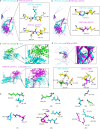Compound heterozygous WNT10A missense variations exacerbated the tooth agenesis caused by hypohidrotic ectodermal dysplasia
- PMID: 38280992
- PMCID: PMC10822191
- DOI: 10.1186/s12903-024-03888-5
Compound heterozygous WNT10A missense variations exacerbated the tooth agenesis caused by hypohidrotic ectodermal dysplasia
Abstract
Background: The aim of this study was to analyse the differences in the phenotypes of missing teeth between a pair of brothers with hypohidrotic ectodermal dysplasia (HED) and to investigate the underlying mechanism by comparing the mutated gene loci between the brothers with whole-exome sequencing.
Methods: The clinical data of the patients and their mother were collected, and genomic DNA was extracted from peripheral blood samples. By Whole-exome sequencing filtered for a minor allele frequency (MAF) ≤0.05 non-synonymous single-nucleotide variations and insertions/deletions variations in genes previously associated with tooth agenesis, and variations considered as potentially pathogenic were assessed by SIFT, Polyphen-2, CADD and ACMG. Sanger sequencing was performed to detect gene variations. The secondary and tertiary structures of the mutated proteins were predicted by PsiPred 4.0 and AlphaFold 2.
Results: Both brothers were clinically diagnosed with HED, but the younger brother had more teeth than the elder brother. An EDA variation (c.878 T > G) was identified in both brothers. Additionally, compound heterozygous variations of WNT10A (c.511C > T and c.637G > A) were identified in the elder brother. Digenic variations in EDA (c.878 T > G) and WNT10A (c.511C > T and c.637G > A) in the same patient have not been reported previously. The secondary structure of the variant WNT10A protein showed changes in the number and position of α-helices and β-folds compared to the wild-type protein. The tertiary structure of the WNT10A variant and molecular simulation docking showed that the site and direction where WNT10A binds to FZD5 was changed.
Conclusions: Compound heterozygous WNT10A missense variations may exacerbate the number of missing teeth in HED caused by EDA variation.
Keywords: Development; Digenic variations; EDA; Hypohidrotic ectodermal dysplasia; Tooth agenesis; WNT10A.
© 2024. The Author(s).
Conflict of interest statement
The authors declare no competing interests.
Figures




Similar articles
-
A novel EDA variant that causes X-linked hypohidrotic ectodermal dysplasia in a Chinese family.BMC Pregnancy Childbirth. 2025 Aug 8;25(1):827. doi: 10.1186/s12884-025-07963-9. BMC Pregnancy Childbirth. 2025. PMID: 40781288 Free PMC article.
-
EDA, EDAR, EDARADD and WNT10A allelic variants in patients with ectodermal derivative impairment in the Spanish population.Orphanet J Rare Dis. 2019 Dec 3;14(1):281. doi: 10.1186/s13023-019-1251-x. Orphanet J Rare Dis. 2019. PMID: 31796081 Free PMC article.
-
[Detection of EDA gene mutation and phenotypic analysis in patients with hypohidrotic ectodermal dysplasia].Beijing Da Xue Xue Bao Yi Xue Ban. 2020 Dec 9;53(1):24-33. doi: 10.19723/j.issn.1671-167X.2021.01.005. Beijing Da Xue Xue Bao Yi Xue Ban. 2020. PMID: 33550332 Free PMC article. Chinese.
-
Orthodontic and dentofacial orthopedic treatments in patients with ectodermal dysplasia: a systematic review.Orphanet J Rare Dis. 2022 Oct 17;17(1):376. doi: 10.1186/s13023-022-02533-0. Orphanet J Rare Dis. 2022. PMID: 36253866 Free PMC article.
-
WITHDRAWN: Dental fillings for the treatment of caries in the primary dentition.Cochrane Database Syst Rev. 2016 Oct 17;10(10):CD004483. doi: 10.1002/14651858.CD004483.pub3. Cochrane Database Syst Rev. 2016. PMID: 27748505 Free PMC article.
References
-
- Salama FS, Abdel-Megid FY. Hypodontia of primary and permanent teeth in a sample of Saudi children. Egyptian dental j. 1994;40(1):625–632. - PubMed
-
- Zhang J, Liu HC, Lyu X, Shen GH, Deng XX, Li WR, Zhang XX, Feng HL. Prevalence of tooth agenesis in adolescent Chinese populations with or without orthodontics. Chin j dental res: the off j Sci Section Chin Stomatol Assoc (CSA). 2015;18(1):59–65. - PubMed
Publication types
MeSH terms
Substances
LinkOut - more resources
Full Text Sources
Molecular Biology Databases

